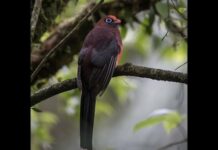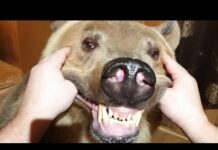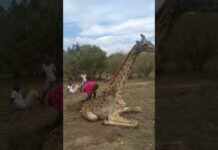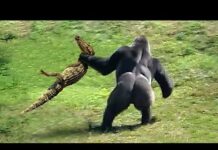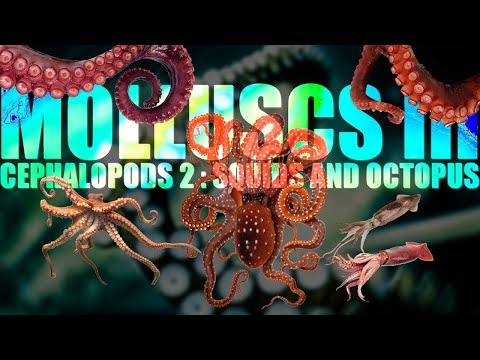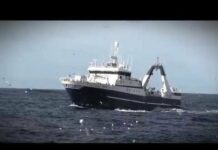Evolution of molluscs 3/3
Squids and octopuses are the biggest molluscs that ever lived, they are also incredibly intelligent animals. They can be found in any oceanic ecosystems and even in deep seas in difficult conditions.
Nautiloids are the first giant animals of the Ordovician, they are very old and Nautilus is the last of us that lives today.
Illustrations by Satoshi Kawasaki
Sources and more informations :
Plectronoceras – https://www.mindat.org/taxon-4625141.html
Phragmoceras – https://www.mindat.org/taxon-4621495.html
Endoceras – https://www.mindat.org/taxon-4625091.html
Orthoceras – https://cindyreedmarketer.com/10/30/2019/top-7-fossil-fun-facts-about-orthoceras/
Cameroceras – http://www.prehistoric-wildlife.com/species/c/cameroceras.html
Rayonnoceras – https://www.mindat.org/taxon-4625351.html
Cyrtoceras – https://www.mindat.org/taxon-P12998.html
Estonioceras – https://www.mindat.org/taxon-4626189.html
Chambered nautilus – https://www.montereybayaquarium.org/animals/animals-a-to-z/chambered-nautilus
Belemnotheutis – https://en.wikipedia.org/wiki/Belemnotheutis
Sichuanobelus – https://www.bagniliggia.it/WMSD/HtmSpecies/8034000045.htm
Giant cuttlefish – https://www.whyalla.com/cuttlefish
Yezoteuthis – https://www.jstor.org/stable/4095091
Haboroteuthis – https://www.nationalgeographic.com/science/article/newfound-fossil-octopus-and-squid-were-giants
Giant squid – http://www.bbc.com/earth/story/20141212-quest-for-the-real-life-kraken
Colossal squid – https://www.marinebio.org/species/colossal-squid/mesonychoteuthis-hamiltoni/
Asperoteuthis – http://tolweb.org/Asperoteuthis_nesisi/143727
Bigfin squid – https://www.theguardian.com/environment/2020/nov/12/bigfin-squid-seen-in-australian-waters-for-first-time
Mastigoteuthis – http://www.marinespecies.org/aphia.php?p=taxdetails&id=138168
Flowerbase jewel squid – https://www.sealifebase.se/summary/Stigmatoteuthis-hoylei.html
Atlantic cranch squid – https://www.sealifebase.ca/summary/Leachia-atlantica.html
Nanaimoteuthis – https://bioone.org/journals/paleontological-research/volume-14/issue-2/1342-8144-14.2.145/Jaws-of-a-New-Species-of-Nanaimoteuthis-Coleoidea–Vampyromorphida/10.2517/1342-8144-14.2.145.short
Vampire squid – https://oceana.org/marine-life/cephalopods-crustaceans-other-shellfish/vampire-squid
Proteroctopus – http://www.prehistoric-wildlife.com/species/p/proteroctopus.html
Telescope octopus – http://www.realmonstrosities.com/2015/07/telescope-octopus.html
Dumbo octopus – https://oceanconservancy.org/blog/2018/10/08/everything-need-know-dumbo-octopus/
Opistoteuthis depressa – https://www.sealifebase.se/summary/Opisthoteuthis-depressa.html
Cirroteuthis – http://tolweb.org/Cirroteuthis/20094
Common octopus – https://www.nationalgeographic.com/animals/invertebrates/facts/common-octopus
Giant pacific octopus – https://www.eaglewingtours.com/articles/8-fun-facts-about-the-giant-pacific-octopus/
Southern blue-ringed octopus – https://oceana.org/marine-life/cephalopods-crustaceans-other-shellfish/southern-blue-ringed-octopus
Wonderpus octopus – https://owlcation.com/stem/The-Wonderpus-Octopus-and-Mimic-Octopus-of-Indonesia-and-Malaysia
0:00 Phylogenetic tree
0:12 Nautiloidea
3:09 Belemnoidea
3:44 Decapodiformes
7:23 Octopodiformes
Najee Lloyds are a large and diverse group of marine cephalopods that began in the late they flourished during the early Paleozoic era where they constituted the main predatory animals and developed an extraordinary diversity of shell shapes and forms disgustoids are unique in the structure and formation of the site fungal the tube.
That runs through and connects the Cambrian cephalopods which unlike those and other orders is zoned longitudinally along the segment's rather than laterally the mode of life of industries is debated they may have been the apex predators of the Ordovician probably living close to the seafloor and brain on trilobite sand other mollusks.
However the extremely long straight shells of industries would have made them slow and not very maneuverable poorly suited for an act of predatory role or alive near the sea floor or Thora's was formally thought to have had a worldwide distribution due to the genus used as a wastebasket taxon for numerous species of conical shell.
Nautiloids the lifestyle and habits of camera saris can only be surmised they were almost certainly stalkers and ambush predators that moved across the sea floor or lay in wait the very largest may have remained on the bottom without ever changing position as with all Indus irradiance cameras Aires was weighted so.
As to be horizontally stable Reyes res is characterized by large straight shells with a large sub central site funcle' composed of sub globular segments the anticip and killer canal system is well developed in most chambers are filled with organic deposits nautiloids began to decline in the Devonian perhaps due to competition.
With their descendants and relatives the a monoids and Koleos with only the not Aleta holding their own the massive extinctions at the end of the Permian were less damaging to Naga Lloyd's than to other taxa and a few groups survived into the early Mesozoic.
The eyes of the chambered nautilus like those of all Nautilus species are more primitive than those of most other cephalopods the eye has no lens and thus is comparable to a pinhole camera it have a pair of Rhino first located near each high which detect chemicals and use olfaction and chemotaxis to find their food.
Belem noids were numerous during the Jurassic and Cretaceous periods and their fossils are abundant in Mesozoic marine rocks often accompanying their cousins the ammonites belin nodes were effectively neutrally buoyant and swam and near shoulder to mid shelf oceans their fins could be used to their advantage in all water.
Speeds in a gentle current they could be flapped for propulsion and when swimming rapidly by jet propulsion they could be tucked into the body for streamlining cuttlefish have sophisticated eyes the organ okay missus in the final structure of the cephalopod I fundamentally differ from those of vertebrates such as humans they are able to communicate visually.
Using a diverse range of signals like dramatic skin texture posture and locomotion cuttlefish are sometimes referred to as the chameleons of the sea because of their ability to rapidly alter their skin color this can occur within one second squibs diverged during the Jurassic but many squid families appeared in or.
After the Cretaceous they have differentiated from the ancestral mollusk such that the Bonnie plan has been condensed anti-ro posteriorly and extended or so ventrally the ancestral shale has been lost with only an internal Gladius remaining the giant squid is the second largest mollusk and one of the largest of all.
Excellent invertebrates but its total length has often been exaggerated maximum total length when measured relaxed postmortem is estimated at 13 meters colossal squid is estimate at 14 meters long making it the largest known invertebrate little is known about the life of this creature but based on captured depths of a few.
Specimens and beaks found in sperm whale stomachs the adult colossal squid ranges at least to a depth of 2,200 meters many sperm whales have scars on their backs believed to be caused by the hoops of colossal squid a spur to thise is characterized by the tiny pointed tubercles present on its skin into y-shaped groove in the funnel.
Locking apparatus the first visual record of the long arms quit dates back to September 1988 at a depth of 4735 meters due to the damaged nature of the find very little information could be discerned particular interest was the very large fin size up to 90% of the mantle length that was responsible for the animals common name mastic a toothy.
Smile is a species of whiplashes quit characterised by a lack of photo furs the skin is heavily pigmented a deep red by a numerous girl middle first in all species of Jewell squids that right eye is normal-sized round blue in sunken whereas the left eye is at least twice the diameter of the right eye tubular yellow green faces upward and.
Bulges out of the head atlantic branch squid possess a remarkable flotation system that enables them to remain in the water column at neutral buoyancy the system uses enormous bilobed coelomic chambers filled with ammonium chloride derived as waste products from their nitrogen metabolism the Vampira morphia are characterized by.
Derived characters such as the possession of photo furs and of tubular filaments which are most probably modified arms with their long velar filaments deployed vampire squids have been observed drifting along in the deep black ocean currents if the filaments contact an entity or if the vibrations impinge upon them the animals.
Investigate with rapid acrobatic movements unlike their relatives living in more hospitable climates deep-sea cephalopods cannot afford to expend energy in protracted flight given their low metabolic rate and the low density of prey at such depths praat rocktopus as a primitive octopod.
That lived in the middle jurassic the single fossil specimen assigned to the species originates from France its morphology suggests in neck low at the pelagic mode of life the illuminated zone at the surface of the sea telescope octopus is the only octopus to have tubular eyes hence the reason it is commonly referred to as telescope.
Octopus it is transparent almost colorless Dumbo octopus flap their ear like fins to propel themselves movement of the arms can be used to help the animal move in any direction it live at depths of at least 3,000 to 4,000 meters with some living up to 7,000 meters below sea level which is the deepest of any known octopus they are some of the.
Rarest of the octopus species umbrella octopuses are characterized by a web of skin between the tentacles causing them to somewhat resemble an opened umbrella when the tentacles are spread they use the webbing between their tentacles to mimic the intermediate web that other sites have in a study of Arctic cephalopods three specimens of co2 thise.
Muller I work on near the ocean floor at 3300 meters the food is believed to consist mainly of small crustaceans training experiments have shown the common octopus can distinguish the brightness size shape and horizontal or vertical orientation of objects they are intelligent enough to learn how to unscrew a jar and are known to raid.
Lobster traps it is a point Gila thermic that it conforms to the ambient temperature Giant Pacific octopus azar commonly kept on display at aquariums due to their size and interesting physiology and have demonstrated the ability to recognize humans that they frequently come in contact with Giant Pacific octopus is Arsenal Burris they.
Breed once before death after reproduction they enter a stage called senescence which involves obvious changes in behavior and appearance southern blue ringed octopus are normally a docile species but they are highly venomous possessing venom capable of killing humans their blue rings appear with greater intensity when they.
Become aggravated or threatened despite their highly toxic venom it tend to be passive and relatively harmless unless provoked wonder piss octopus has well-defined white spots on the mantle and bars on the arms the white spots are unique among individuals allowing for the use of photo identification to monitor individuals in the wild it.
Hatchlings can be identified by their unique founder chromatophore patterns you
We are excited to present to you the captivating video titled “Molluscs III : Cephalopods (part 2) 🦑 Squids and Octopus 🐙”. Get ready to embark on a journey of enjoyment, smiles, and laughter as you watch this delightful creation. “Molluscs III : Cephalopods (part 2) 🦑 Squids and Octopus 🐙” is a perfect blend of entertainment and amusement, carefully crafted to bring joy to your day. From the moment you press play, you’ll be greeted with a cascade of lighthearted moments, heartwarming scenes, and perhaps even a few surprises that will tickle your funny bone.
Whether you’re in need of a quick pick-me-up or simply looking for some light-hearted entertainment, “Molluscs III : Cephalopods (part 2) 🦑 Squids and Octopus 🐙” has you covered. The video promises to deliver a collection of moments that are bound to leave you grinning from ear to ear. With its engaging content and skillful presentation, “Molluscs III : Cephalopods (part 2) 🦑 Squids and Octopus 🐙” is more than just a video – it’s an experience designed to brighten your mood and spread positivity.
The creators of “Molluscs III : Cephalopods (part 2) 🦑 Squids and Octopus 🐙” have poured their creativity and dedication into crafting a visual treat that resonates with audiences of all ages. Through expert storytelling, impeccable timing, and an array of engaging content, “Molluscs III : Cephalopods (part 2) 🦑 Squids and Octopus 🐙” promises to be an unforgettable journey that lingers in your memory long after the video concludes.
So sit back, relax, and prepare to be entertained as you dive into the world of “Molluscs III : Cephalopods (part 2) 🦑 Squids and Octopus 🐙”. It’s a delightful video that aims to bring a dose of happiness to your day, leaving you with a lasting smile and a heart full of laughter.
This video was uploaded in youtube and has recieved 31831 views so far. This is a great achievement and laso it has received 537 likes and .
Data bout the video:
Rating: ,
Video dimensions: 2d,
Video definition: hd,
Video duration: 00:11:57,
Video favourite count: 0
Video comment count: 45


